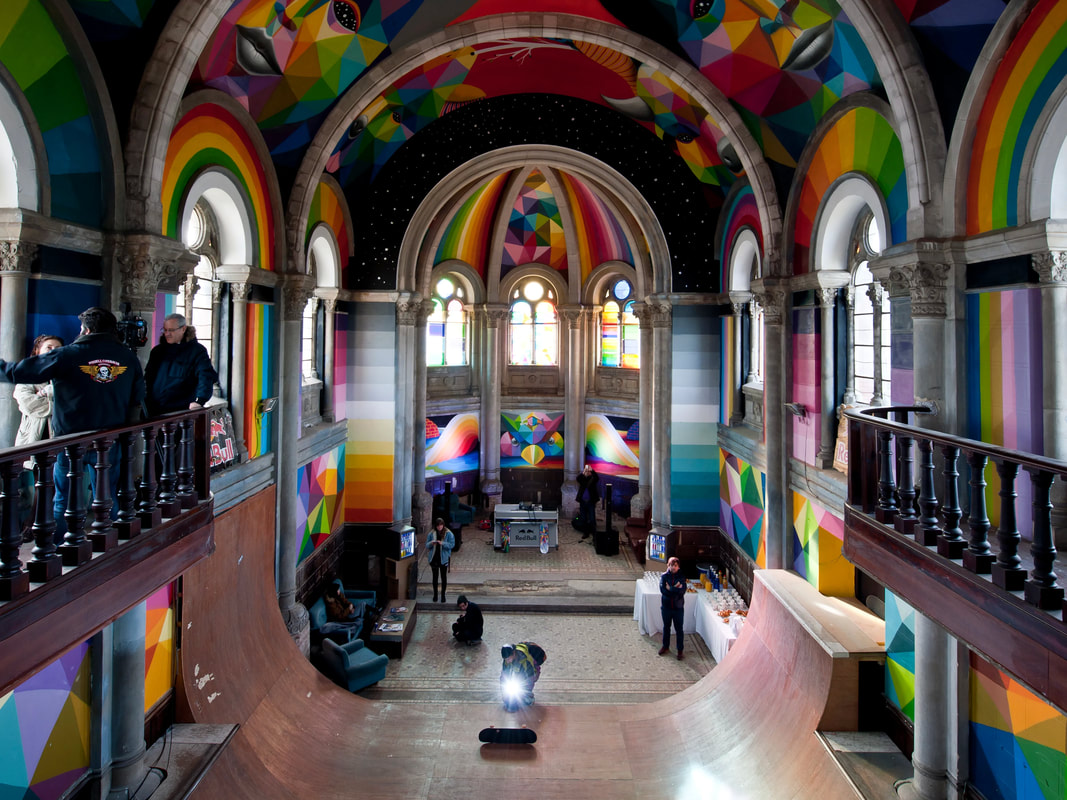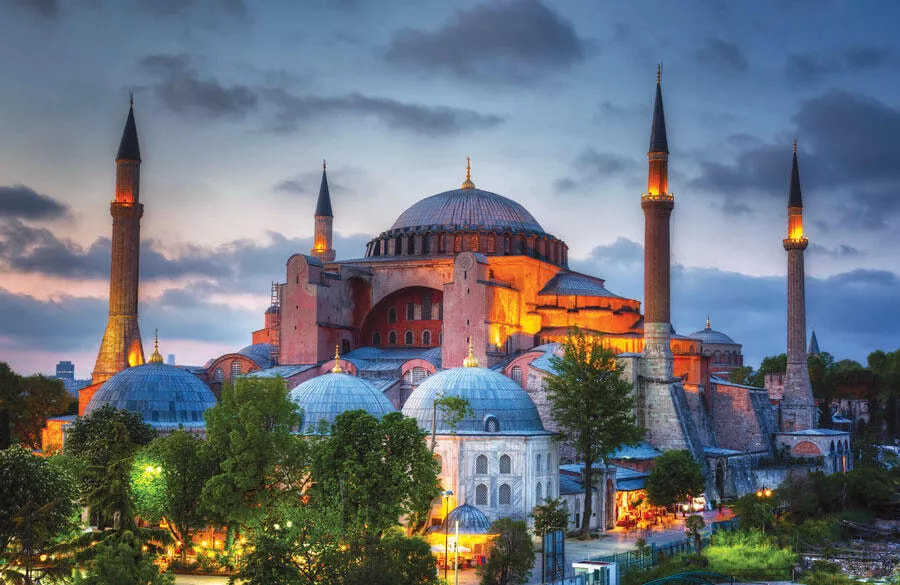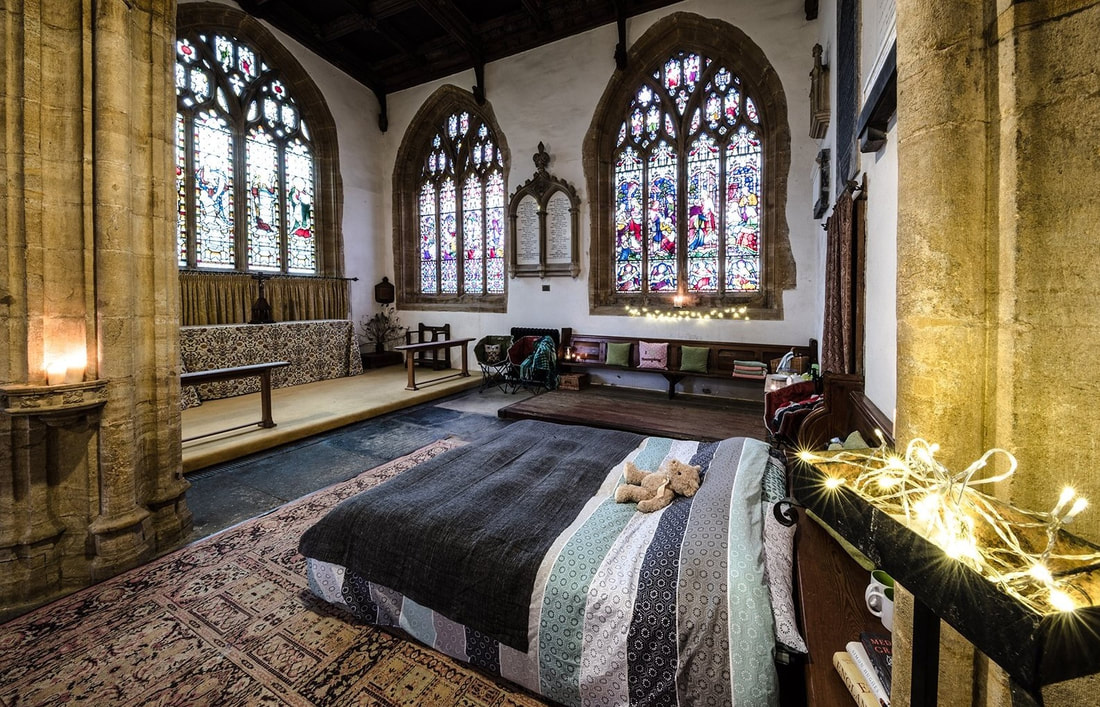In my lifetime I have visited a lot of holy places around the world. But if I were to go Champing in any one of them, well it would have to be the Sagrada Familia Basilica in Barcelona, Spain. My first time there, I just stood in the naive and wept. It is the most beautiful and colorful and imaginative place I’ve ever been.
This impressive and awe-inspiring church was the life work of the brilliant artist Antoni Gaudí, who began the project knowing he’d never see it through completion. My friend Julian once asked me “What would be that one project you’d like to do, knowing that you would never see it completed in your life time?” He had me write my answer in a sketch book I was holding. I just recently looked in that book. And do you know what project I wrote down? “To (re)define what church is.” Not to remake it or reimagine what it is, but to define it in all the ways I live my life. I feel like this is what we are called to do, and what we are doing today. We are a church, a holy body of people, redefining that definition by breaking the mold of what we have come to think church should be. In two weeks, we will become Anamesa. I have no idea what it will look like or become. But I know how and where it will begin. Not inside a building. But in a faithful heart where God has been champing all along. Today, Jesus and his disciples are leaving the Jerusalem Temple for the last time. When someone in his group makes a comment on its impressive size, Jesus had this to say: Read Mark 13:1-2 “Do you see these great buildings? Not one stone will be left here upon another; all will be thrown down.”
To say the Jerusalem Temple was an architectural achievement might be an understatement. Today, it’s still considered one of the seven wonders of the ancient world. And for good reason. King Herod spared no expense to impress the wealthiest and most powerful rulers of his era. Scripture tells us that the Temple was the center of Jewish worship. And because of its geographical location, we could argue it put God in the center of the known world.
According to historical records, the Temple was roughly 3 football fields wide by 5 football fields long. The enormous stones of its foundation, the one’s referred to in this story, each measured 40 feet. The façade of the main entrance was covered with so much silver and gold that in the bright sunlight it blinded anyone who looked at it. It had sprawling courtyards, grand porches, covered walkways, and a monumental staircase that was a spectacular sight for sure. The paint wasn’t even dry on the place when Jesus very publicly declared, it would “all will be thrown down.” So you can imagine the shock the disciples must have felt when they heard it. You’d think they’d be used to Jesus saying weird things like this. But back at the campsite, they press him to reveal exactly when it all will happen. Read Mark 13:3-8
In light of all the bad news that is fed to us every day, I can see why some are uneasy with this apocalyptic passage.
Roger Nishioka writes, “Towering buildings are not supposed to crumble. Oceans are not supposed to leap out of the sea and flood miles inland. The ground is not supposed to shake under our feet. The sky is not supposed to form a funnel cloud and destroy the town. But all who have watched the world trade towers collapse, seen a tsunami flood a nation, experienced an earthquake or suffered through the powerful tornado know that such events happen.” If we think about all the storms we have weathered in the last 18 months, it’s hard to find any comfort when Jesus says, “This is but the beginning of the birth pangs.” Still, it doesn’t stop a few of my friends from using these tragic events to formulate when the second coming of Christ will happen. Many have concluded that time is now. But Jesus said, “These are just the birth pangs.” In other words, “Something new is coming.” I might be skeptical of my friend’s predictions on the end of the world. But I do sympathize with their troubled spirit. I was in Indianapolis with my dad for the Men’s Final Four tournament, when I thought the end of the world was upon us. We had just left the restaurant after dinner when we noticed the streets – which had been packed with thousands of partygoers – were now empty. The only thing left were massive puddles and a lingering eerie feeling in the air. As we walked back to our hotel, we heard a sound in the distance. One we didn’t recognize until the hail started dropping. Empty wet streets. Sirens. Hail. You could say God was giving us a pretty clear warning that something bad was about to come. We needed to get to safety. And fast. Now my real fear kicked in when I realized we were standing in the middle of an empty stadium parking lot. I could see our hotel in the distance, but it was still a couple of blocks away. With nowhere to hide, we took off running. And made it to our hotel room just as the tornado touchdown on the very spot we had been standing. Still wet with rain, I was freaked out while my dad stretched out on the bed and began to read a book without a care in the world. To his credit, we don’t know when the end time will come. But we do know that we have been give this time to live, not in fear but in faith. So, it’s hard for me to imagine Jesus is using weird apocalyptic imagery to scare his disciples. Perhaps they were obsessing a little too much over what he was telling them. And perhaps Jesus said those things to remind them where to place their faith and focus. This is a wakeup call for us as well. We, like the disciples, can lose focus trying to figure out the signs of the time. We often allow politics, work, and bad news to take our eyes off the more important mission – to witness to the Good News that Jesus has ushered in. Let’s be real, we don’t know when Christ will come again. But we do know that Christ has already come and instructed us on what we are to do today. As long as there are natural disasters and human error that cause God’s children to suffer, there’s work to be done. This is a good of place as any to begin defining what church is.
St Peter’s Basilica, which is the home church of the Pope himself, draws millions of people through its doors every year. While it might be fun to go Champing under the roof of the Sistine Chapel, it seems contradictory to what God is calling us to do: to get out of the building and be in the world as the visible presence of God’s redemptive love.
God wants us out in the world defining what it means to be the church, the very body of Christ himself. Because the way I see it, of all the millions of churches, mosques, temples, and synagogues out there, not one is as beautiful or as impressive or stunning as you. God doesn’t need a building. God needs bodies. God needs you and me to show up in the holy and sacred space of life where there is real hurt and real pain and a real need for God’s presence. Buildings can be destroyed or invaded or simply shut down because of lack of funds or interest; proving that things made by human hands are temporary. But we are made by God’s hands. In God’s image. And through Christ Jesus, we are made everlasting. As St. Peter writes, we are “Living stones...chosen and precious in God’s sight...to be built into a spiritual house...through Jesus Christ” (1 Peter 2:4-5). No fire, earthquake, or global pandemic can destroy what God has done in the world. Nor can it disrupt what God is doing right now. With us and for us through our Lord. In two weeks, we will kick off Advent with a new name. We chose this day, not because it’s the new church year, but because it marks a season of waiting for something greater to come. I’ll admit I have my moments of fear. I worry what changing our name might do with what we’ve already built. I see this gospel story as a reminder to be faithful in our waiting because something new is unfolding. Weird things happen that we have no control over. We can’t predict what is to come. But no matter what happens, we can prevail because we are the body of Christ, which not even death can destroy. Anamesa isn’t just a name. It’s a way to walk, and run, and cry, and laugh, and sing, and worship and love together in that space between. It is a way we come together in the name of Christ Jesus, to define the church, fully and faithfully. It is a way for us to show up together, as the light and love of Christ himself to meet the needs of those crying out. It’s a way to bring hope, and peace, and healing and restoration in our divided world where today it’s needed badly.
Work Cited
Content collected from original sermons on Nov. 15, 2015 and Nov 18, 2018. Bartlett, David L and Barbara Brown Taylor, eds. Feasting on the Word, Year B. Vol. 4. (Louisville: Westminster John Knox Press, 2009)
0 Comments
Leave a Reply. |
Ian MacdonaldAn ex-copywriter turned punk rock pastor and peacemaker who dedicates his life to making the world a better place for all humanity. "that they all might be one" ~John 17:21“Prius vita quam doctrina.”
~ St. Thomas Aquinas (1225–1274) * “Life is more important than doctrine.”
Archives
June 2024
|


